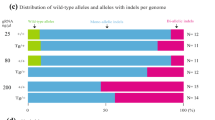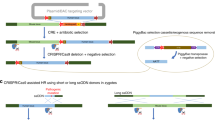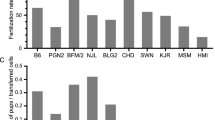Abstract
Genetic modification of endogenous genes in mice has become possible by applying gene targeting techniques to embryonic stem (ES) cells and using specific clones of cells to generate mice. Despite the experimental opportunities offered by the creation of organisms with specific genetic changes, there are considerable technical obstacles which can confound the routine implementation of this technology. This review addresses some recent advances in the ability to construct mice with a variety of genetic modifications. These include an increased understanding of the basic cell biology and in vitro growth characteristics of ES cells, which has facilitated germ line transmission of manipulated clones on a routine basis. The techniques that are used to isolate “targeted” clones of ES cells have been summarized, and the current status of strategies which have been successfully used to make very specific modifications of the genome are discussed.
This is a preview of subscription content, access via your institution
Access options
Subscribe to this journal
Receive 12 print issues and online access
$209.00 per year
only $17.42 per issue
Buy this article
- Purchase on Springer Link
- Instant access to full article PDF
Prices may be subject to local taxes which are calculated during checkout
Similar content being viewed by others
References
Palmiter, R.D. and Brinster, R.L. 1986. Germ line transformation of mice. Ann. Rev. Genet. 20: 465–499.
Evans, M.J. and Kaufman, M.H. 1981. Establishment in culture of pluripotential cells from mouse embryos. Nature 292: 154–156.
Bradley, A., Evans, M.J., Kaufman, M.H. and Robertson, E.J. 1984. Formation of germ line chimaeras from embryo-derived teratocarcinoma cell lines. Nature 309: 255–256.
Thomas, K.R. and Capecchi, M.R. 1987. Site-directed mutagenesis by gene targeting in mouse embryo-derived stem cells. Cell 51: 503–512.
Kuehn, M.R., Bradley, A., Robertson, E.J. and Evans, M.D. 1987. A potential animal model for Lesch-Nyhan syndrome through introductions of hprt mutations into mice. Nature 326: 295–298.
Schwartzberg, P.I., Goff, S.P. and Robertson, E.J. 1989. Germ-line transmission of a c-abl mutation produced by targeted disruption in ES cells. Science 246: 799–804.
Robertson, E.J., Bradley, A., Kuehn, M. and Evans, M.J. 1986. Germ line transmission of genes introduced into cultured pluripotential cells by a retroviral vector. Nature 323: 445–448.
Bradley, A. 1990. Embryonic stem cells: Proliferation and differentiation. Current Opinion in Cell Biology 2: 1013–1017.
Robertson, E.J. 1987. Embryo-derived stem cells lines, 71–112. In: Teratocarcinomas and Embryonic Stem Cells: A Practical Approach. E.J. Robertson (Ed.). IRL Press, Oxford, UK. .
Smith, A.G. and Hooper, M.L. 1987. Buffalo rat liver cells produce a diffusible activity which inhibits the differentiation of embryonal carcinoma and embryonic stem cells. Dev. Biol. 121: 1–9.
Williams, R.L., Hilton, D.J., Pease, S., Willison, T.A., Stewart, C.L., Gearing, D.P., Wagner, E.F., Metcalf, D., Nicola, N.A. and Gough, N.M. 1988. Myeloid leukemia inhibitory factor maintains the developmental potential of embryonic stem cells. Nature 336: 684–686.
Pease, S. and Williams, R.L. 1990. Formation of germ line chimaeras from embryonic stem cells maintained with recombinant leukemia inhibitory factor. Exp. Cell Res. 190: 209–211.
Zijlstra, M., Li, E., Sajjadi, F., Subramani, S. and Jaenisch, R. 1989. Germ-line transmission of a disrupted β2-microglobulin gene produced by homologous recombination in embryonic stem cells. Nature 342: 435–438.
McMahon, A.P. and Bradley, A. 1990. The Wnt-1 (Int-1) proto-oncogene is required for the development of a large region of the mouse brain. Cell 62: 1073–1085.
Stanton, B.R., Reid, S.W. and Parada, L.F. 1990. Germ line transmission of an inactive N-myc allele generated by homologous recombination in mouse embryonic stem cells. Mol. Cell Biol. 10: 6755–6758.
Tybulewicz, V.L.J., Crawford, C.E., Jackson, P.K., Bronson, R.T. and Mulligan, R.C. 1991. Neonatal lethality and lymphopenia in mice with a homozygous disruption of the c-abl proto-oncogene. Cell 65: 1153–1164.
Soriano, P., Montgomery, C., Geske, R. and Bradley, A. 1991. Targeted disruption of the c-src proto-oncogene leads to osteopetrosis in mice. Cell 64: 693–702.
Thomas, K.R. and Capecchi, M.R. 1990. Targeted disruption of the murine int-1 proto-onco gene resulting in severe abnormalities in the midbrain and cerebellar development. Nature 346: 847–850.
teRiele, H., Maandag, E.R., Clarke, A., Hooper, M. and Berns, A. 1990. Consecutive inactivation of both alleles of the pim-1 proto-oncogene by homologous recombination in embryonic stem cells. Nature 348: 649–651.
Friedrich, G. and Soriano, P. 1991. Promoter traps in embryonic stem cells: a genetic screen to identify and mutate developmental genes in mice. Genes & Dev. 5: 1513–1523.
DeChira, T.M., Efstatiadis, A. and Robertson, E.J. 1990. A growth deficiency phenotype in heterozygous mice carrying an insulin like growth factor II gene disrupted by targeting. Nature 345: 78–80.
Chiska, O. and Capecchi, M.R. 1991. Regionally restricted developmental defects resulting from targeted disruption of the mouse homeobox gene Hox 1.5. Nature 350: 473–479.
Thompson, S., Clarke, A.R., Pow, A., Hooper, M.L. and Melton, D.W. 1989. Germ-line transmission and expression of a corrected HPRT gene produced by gene targeting in embryonic stem cells. Cell 56: 313–321.
Joyner, A.L., Auerbach, B.A., Davis, C.A., Herrup, K. and Rossant, J. 1991. Subtle cerebellar phenotype in mice homozygous for a targeted deletion of the En2 homedomain. Science 251: 1239–1243.
Hasty, P., Ramírez-Solis, R., Krumlauf, R. and Bradley, A. 1991. Introduction of a subtle mutation into the Hax-2.6 locus in embryonic stem cells. Nature 350: 243–246.
Smithies, O., Gregg, R.G., Boggs, S.S., Koralewski, M.A. and Kucherlapati, R.S. 1985. Insertion of DNA sequences into the human chromosomal β-globin locus by homologous recombination. Nature 317: 230–234.
Hasty, P., Rivera-Pérez, J. and Bradley, A. 1991. The length of homology required for gene targeting in embryonic stem cells. Mol. Cell Biol. 11: 5586–5591.
Hasty, P., Rivera-Pérez, J., Chang, C. and Bradley, A. 1991. Target frequency and integration pattern for insertion and replacement vectors in embryonic stem cells. Mol. Cell. Bio. 11: 4509–4517.
Schwartzberg, P.L., Robertson, E.J. and Goff, S.P. 1990. Targeted disruption of the endogenous c-abl locus by homologous recombination with DNA encoding a selectable fusion protein. Proc. Natl. Acad. Sci. U.S.A. 87: 3210–3214.
Charron, J., Malynn, B.A., Robertson, E.J., Goff, S.P. and Alt, F.W. 1990. High-frequency disruption of the N-myc gene in embryonic stem and pre-B cell lines by homologous recombination. Mol. Cell Biol. 10: 1799–8084.
Donehower, L.A., Harvey, M., Slagle, B., McArthur, M.J., Montgomery, C.A., Butel, J.S. and Bradley, A. 1992. Mice deficient for p53 are developmentally normal but susceptible to spontaneous tumours. Nature 356: 215–221.
Mansour, S.L., Thomas, K.R. and Capecchi, M.R. 1988. Disruption of the proto-oncogene int-2 in mouse embryo-derived stem cells: a general strategy for targeting mutations to non-selectable genes. Nature 336: 348–352.
Joyner, A.L., Skarnes, W.C. and Rossant, J. 1989. Production of a mutation in the mouse En2 gene by homologous recombination in embryonic stem cells. Nature 338: 153–156.
Ramirez-Solis, R., Rivera-Perez, J., Wallace, J.D., Wims, M., Zheng, H. and Bradley, A. 1992. Genomic DNA microextraction: a method to screen numerous samples. Analytical Biochemistry 201: 331–335.
Mansour, S.L., Thomas, K.R., Deng, C.X. and Capecchi, M.R. 1990. Introduction of a lacZ reporter gene into the mouse int-2 locus by homologous recombination. Proc. Natl. Acad. Sci. U.S.A. 87: 7688–7692.
Le-Mouellic, H., Lallemand, Y. and Brulet, P. 1990. Targeted gene replacement of the homeobox gene Hox-3.1by the Escherichia coli lacZ in mouse chimeric embryos. Proc. Natl. Acad. Sci. U.S.A. 87: 4712–4716.
Zimmer, A. and Gruss, P. 1989. Production of chimaeric mice containing embryonic stem (ES) cells carrying a homeobox Hox1.1 allele mutated by homologous recombination. Nature 338: 150–153.
Davis, A.C. and Bradley, A. 1992. Co-electroporation as a method for introducing small mutations into embryonic stem cells. Mol. Cell Biol. In press
Shesely, E.G., Kim, H.S., Shehee, W.R., Papayannopoulou, T., Smithies, O. and Popovich, B.W. 1991. Correction of a human beta S-globin gene by gene targeting. Proc. Natl. Acad. Sci. U.S.A. 88: 4294–4298.
Schnieke, A., Harbers, K. and Jaenisch, R. 1983. Embryonic lethal mutation in mice induced by retrovirus insertion into the α1(l) collagen gene. Nature 304: 315–320.
Nusse, R. 1986. The activation of cellular oncogenes by retroviral insertion. Trends Genet 2: 244–247.
Valancius, V. and Smithies, O. 1991. Testing an “In-Out” targeting procedure for making subtle genomic modifications in mouse embryonic stem cells. Mol. Cell Biol. 11: 1402–1408.
Bradley, A., Ramirez-Solis, R., Zheng, H., Hasty, P. and Davis, A.C. 1992. Genetic manipulation of the mouse via gene targeting in embryonic stem cells. In: Ciba Foundation-Post Implantation Development of the Mouse. In press.
Grosveld, F., Blom van Assendelft, G., Greaves, D.R. and Kollias, G. 1987. Position-independent, high level expression of the human β-globin gene in transgenic mice. Cell 51: 975–985.
Pavan, W.J., Hieter, P. and Reeves, R.H. 1990. Modification and transfer into an embryonal carcinoma cell line of a 360-kilobase human derived artificial chromosomes. Mol. Cell. Bio. 10: 4163–4169.
Notarianni, E., Laurie, S., Moor, R. and Evans, M.J. 1990. Maintenance and differentiation in culture of pluripotential embryonic cell lines from pig blastocysts. J. Reprod. Fert. Suppl. 41: 51–56.
Piedrahita, J.A., Anderson, G.B. and BonDurant, R.H. 1990. On the isolation of embryonic stem cells: Comparative behaviour of murine, porcine and ovine embryos. Theriogenology 34: 865–878.
Author information
Authors and Affiliations
Rights and permissions
About this article
Cite this article
Bradley, A., Hasty, P., Davis, A. et al. Modifying the Mouse: Design and Desire. Nat Biotechnol 10, 534–539 (1992). https://doi.org/10.1038/nbt0592-534
Issue Date:
DOI: https://doi.org/10.1038/nbt0592-534
This article is cited by
-
Transgenic Livestock as Bioreactors: Stable Expression of Human Alpha-1-Antitrypsin by a Flock of Sheep
Nature Biotechnology (1993)



